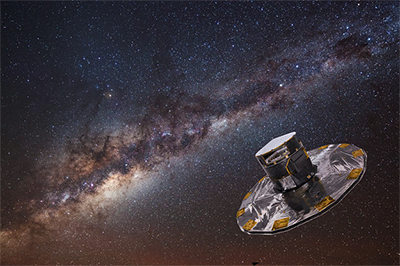16 December 2013
The European Gaia satellite will be launched into space on 19 December, from a launch base in French Guiana, to make an extremely detailed map of the Milky Way. Leiden astronomer Anthony Brown is leading the consortium that will be processing the flood of measurement data.
Super-precise measurements
Gaia – an acronym for Global Astrometric Interferometer for Astrophysics and the name for Mother Earth in Greek mythology – will spend the next five years ‘examining’ one billion stars. The space probe will measure the distance between these stars, and their position, using highly sensitive devices. For example: the two optical telescopes on board the probe are able to determine the diameter of a human hair at a distance of one thousand kilometres.
Finding answers
Astronomers expect that the data Gaia sends back to Earth will uncover countless new celestial objects. They also hope to find answers to pressing questions such as: What are the origins of the Milky Way? What role does dark matter play in the Universe?
Translating measurement data
Processing the data is going to be a huge job, because unlike for example the Hubble space telescope, Gaia does not produce data that can be directly applied to scientific research. A pan-European collaboration team will be translating these raw measurements into workable information on matters such as movement, temperature, chemical composition and the age of the stars
Results available to the public
Leiden astronomer Anthony Brown is head of this Gaia Data Processing and Analysis Consortium (DPAC). The consortium consists of more than 400 researchers and software developers from 24 European countries. They are responsible for the design, maintenance and use of the data processing system. ‘What is unique about the Gaia project is that there is no proprietary period for the scientific data that this DPAC produces. After completion of each processing cycle, the scientific data is immediately made available to the academic community and the general public,’ says Brown on the weblog of the Gaia project.













